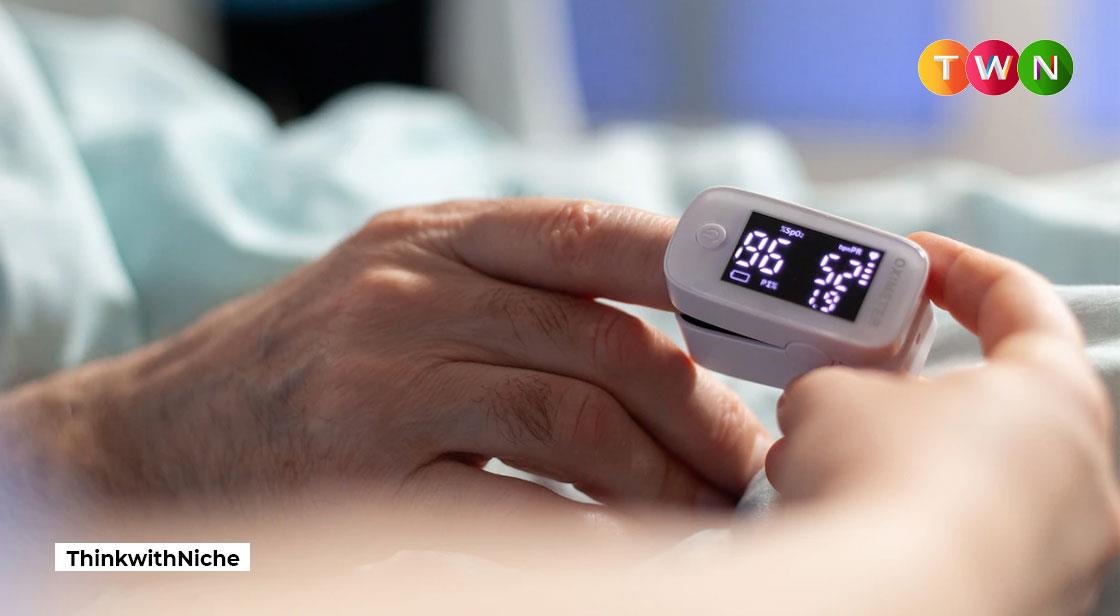How To Increase Blood Oxygen Level And Improve Performance

Blog Post
Increasing the oxygen level in your blood is an important aspect of sports and fitness. If you're looking to increase blood oxygen levels, there are many ways to achieve this. Here is an article that would help you increase oxygen levels for better performance. Read on! #TWN
The oxygen saturation level, also known as blood oxygen level, is a percentage that represents the total amount of oxygen circulating in the blood. This amount is calculated by comparing the amount of circulating hemoglobin that is oxygen-linked to the amount that is not. Hemoglobin is a protein found in red blood cells that transports oxygen from the lungs to different parts of the body.
The blood oxygen level should ideally be as close to 100 percent as possible, preferably above 95 percent, as this indicates that there is sufficient oxygen circulating. People with chronic respiratory problems, such as asthma or chronic obstructive pulmonary disease (COPD), may have lower saturation levels (88-90 percent), which is a normal and unremarkable finding.
When an oxygen saturation level drops rapidly or falls below 85-90 percent, it may indicate a serious health problem such as pneumonia, heart failure, or anemia. These situations necessitate immediate evaluation and diagnosis at the hospital, as well as treatment as soon as possible.
How to Increase Blood Oxygen Levels
When oxygen saturation in a healthy person is low, between 90 and 95 percent, it may be a sign of phlegm in the airways, which may be reducing the amount of oxygen that gets to the blood. It is why a drop in saturation levels is common when you have the flu or a cold.
Some simple steps you can take right away to boost blood oxygen levels include:
- Coughing to mobilize secretions and improve oxygenation.
- Sitting upright rather than lying down to relieve pressure on the lungs.
- Taking a slow, deep breath to increase the amount of air entering the lungs.
- To ensure a higher level of oxygen, go somewhere that is well ventilated.
- Avoid places that are extremely hot or cold, as these can make breathing difficult.
Increase Oxygen Levels over the Long-term
Some people may have low or fluctuating oxygen levels for an extended period. Certain respiratory conditions, such as chronic obstructive pulmonary disease (COPD) or emphysema, can cause this. Patients who have a longer-term oxygenation problem can try to increase their levels by performing exercises that promote chest well expansion and more effective inhalation regularly. These are some examples of such exercises:
Postural Drainage
Lay on your back on an incline with your head lower than your body. You can do this for 30 seconds 3 to 4 times per day. It will help to mobilize secretions, making coughing easier.
Abdo-diaphragmatic Breathing
Put one hand on your belly button and the other between your nipples on your chest. Breathe slowly through your nose, focusing on lifting your hand from your belly button and keeping your hand still on your chest. Slowly exhale through pursed lips. It will aid in thoracic wall movement and air distribution through the chest.
Holding your Breath
Close your eyes and imagine yourself riding an elevator up a building. When you reach the first floor, inhale slowly for a second, then hold your breath. As you reach the second floor, continue to inhale for another 2 seconds before pausing again. Then, inhale for 3 seconds and repeat until you can no longer inhale any further. You can repeat this 3 to 5 times per day, resting after each attempt.
Straw Breathing
For this exercise, you will need a cup of water and a straw. Inhale deeply and hold for 1 second before slowly exhaling through the straw to blow bubbles into your cup of water. You can only do this ten times while sitting or standing.
Saturation levels of less than 85 percent to 90 percent may indicate a more serious health problem, such as pneumonia. As a result, it is advised that you visit a hospital or call for medical assistance for a more thorough examination. While you wait for medical assistance, you can use the techniques outlined above to increase saturation while decreasing respiratory effort.
It is important to remember that several chronic conditions, such as asthma, anemia, COPD, emphysema, or heart problems, can cause a decrease in saturation without indicating an emergency. In these cases, it's critical to consult with a doctor to determine what saturation levels are considered normal.
Benefits of Increased Blood Oxygen Levels in Body
When you increase blood oxygen levels in body, it can help your body get more oxygen. It is a great way to improve performance, allowing you to work out longer or be more energetic for the entirety of your day. Also, this simple technique can have several other benefits:
1. It can help relieve stress
2. It can give you increased stamina when exercising
3. It can make sports activities easier and less tiring
4. It can lower your heart rate during exercise
5. It helps with recovery from workouts
6. It improves cognitive functions (brain function)
Why Oxygen Levels are Important
Along with heart rate, blood pressure, respiratory rate, and body temperature, oxygen saturation is regarded as one of the most important vital signs in a medical examination. The level of blood oxygen is directly related to abnormalities or illness within the body, and a low level can indicate a serious health problem such as:
- Breathing problems: COPD, asthma, embolism, emphysema, cystic fibrosis;
- Heart disease: congenital defects or heart failure;
- Anemia
In addition to assisting in diagnosis, oxygen saturation can be used to track how well a patient is responding to treatment for a specific condition.
Breathing Exercises to Increase Oxygen Saturation
When you inhale and exhale, your lungs take oxygen to the bloodstream. This way, you start to get more oxygen going straight to your cells. When you are exercising, you must use as much oxygen as possible! One way to do this is by breathing exercises that increase blood oxygen levels and improve performance. These breathing exercises can be done at different times of the day, but the most important time is during the workout.
To experience better results from your exercise routine, try these three simple breathing exercises:
1. Deep Breathing
Inhale deeply and exhale fully with each breath through your mouth while counting out loud:
1-2-3-4-5-6 (inhale)
7-8-9-10-11 (exhale)
12-13-14-15 (recover)
16 (repeat).
2. Nose Breathing
Inhale through your nose for a count of five and then exhale through your mouth for a count of four on an inhaled/exhaled cycle. Perform this cycle three times every minute for a total of six minutes. For example:
Inhale 1 - 4 - 5 - 4 - 2 - 1 (inhale)
Exhale 4 - 3 - 2 - 5 - 4 - 3 (exhalate)
How COVID-19 and Oxygen Saturation are Related
COVID-19 is a virus that primarily affects the respiratory system. It causes symptoms such as a dry cough, tightness in the chest, difficulty breathing, and fatigue. The oxygen level is expected to fall slightly in people infected with COVID-19 because the lungs are not functioning normally and cannot exchange oxygen properly.
In people with COVID-19, oxygen saturation should be kept above 90-95 percent. If the patient's levels fall below this range, he or she should be evaluated, and the doctor may decide to start him or her on oxygen therapy in the hospital.
In more serious COVID-19 cases, blood oxygen levels can fall below 80%, necessitating hospitalization, usually in an intensive care unit (ICU).
How to Measure Oxygen Levels
The level of oxygen in the blood can be measured using a test known as oximetry. This test can be carried out in two ways:
Pulse Oximeter
It is the most common and simplest method of measuring oxygen saturation. It is made up of an oximeter that is placed on the tip of the finger. This device will measure oxygen levels by directing a laser through the fingernail, eliminating the need for a finger prick or blood sample.
Arterial Blood Gas
It is a less common option, but it is the most accurate way of determining the exact amount of oxygen in the blood. It necessitates the collection of a blood sample from an artery, which will be analyzed in the laboratory. Other important values revealed by arterial blood gas testing include blood pH, partial pressure of oxygen (pO2), and partial pressure of carbon dioxide (pCO2).
Oximetry tests can be performed at home using a pulse oximeter. These are usually available at a pharmacy or a medical supply store. When using one at home, make sure your fingers are relatively warm and placed on a fingertip that is free of nail polish or artificial nails, as this will ensure a more precise result.
Normal Blood Oxygen Levels
Normal blood oxygen levels differ depending on a person's medical history. When oxygen levels exceed 95 percent in people who are otherwise healthy and do not have a history of chronic diseases, oxygen levels are considered normal. Most of the time, saturation levels above 98 percent are normal.
However, in people with a history of respiratory diseases (such as COPD or asthma), oxygen saturation can range from 88 to 95 percent. Blood oxygen levels less than 95% should always be evaluated by a doctor who can determine which range is considered normal. This normal range will be determined by the patient's medical history.
Best Food to Optimize Blood Flow
- Cayenne Pepper
- Pomegranate
- Onions
- Cinnamon
- Garlic
- Fatty Fish
- Beets
- Turmeric
- Leafy Greens
- Citrus Fruits
- Walnuts
- Tomatoes
- Berries
- Ginger
Also Read: Health Benefits of Eating Healthy and Avoiding Unhealthy Food
Conclusion
What is the best way to increase blood oxygen levels?
The answer is to increase oxygen saturation with a technique called hyperventilation.
The benefits of increased blood oxygen levels include increased endurance, improved performance, and enhanced mental clarity.
The technique is simple: take a deep breath, hold your breath for 10 seconds and exhale forcefully. Make sure you continue to breathe normally after 10 seconds. The result is a significant increase in oxygen levels in the blood.
Besides, it’s easy to use this technique at home, and you don’t even have to leave your home!
You May Like
EDITOR’S CHOICE












